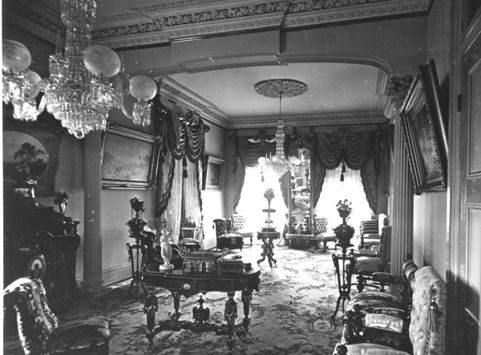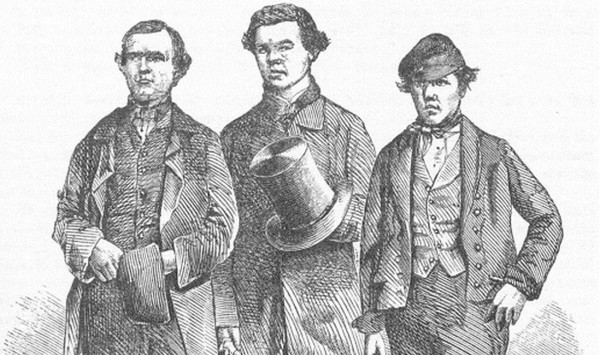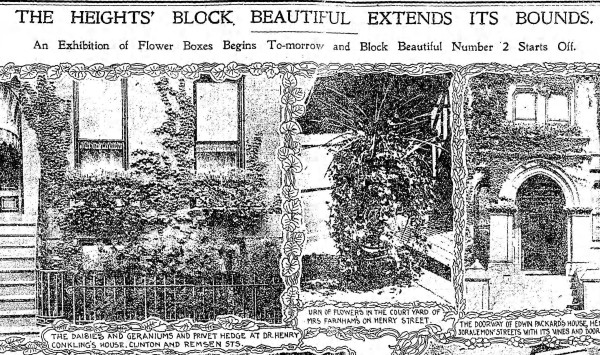PATRONAGE & PLUMS, No. 398 HENRY ST (1895)

********************************************************************************************************************************Brownstone Detectives investigates the history of our clients’ homes.The story you are about to read was composed from research conducted in the course of one of those investigations.Do you know the history of YOUR house?******************************************************************************************************************************** “The house is a three-story and basement structure. As it is now, the basement is transformed into a pool and billiard room, and from the cellar to the roof the premises are heated. The parlor, of course, comprise the second floor. There is an expanse of Brussels carpet which covers the entire space; in the rear parlor is a business desk, and in the front of it the president’s seat, for the parlors comprise the meeting room of the association and from four to five hundred people can easily be accommodated. Specials chairs are provided when a meeting is to be held, but on other occasions the members are allowed to utilize the furniture for their own comfort. There is not an upholstered chair on this floor which is not an easy one; there is not a lounge or sofa which is not inviting. The walls are papered tastefully, the oil paintings which hand upon them are masterpieces of art and good judgment. The ornamental fireplaces are surmounted with open cabinet work, in the sections of which are enshrined choice bric-a-brac. “Between the front parlor windows hangs the picture of the ward leader, ex-Register James Kane. On the southern wall is the crayon resemblance of Peter Fagan, one of Mr. Kane’s closest friends, and who […]
THE HUNGRY BURGLARS OF HENRY ST. (1890)

******************************************************************************************************************************** Brownstone Detectives investigates the history of our clients’ homes. The story you are about to read was composed from research conducted in the course of one of those investigations. Do you know the history of YOUR house? ******************************************************************************************************************************** Not all burglars are intent on “getting in and out quick.” And so it was when, in 1890, two Brooklyn thieves, during a burglary of a Brooklyn Heights home, actually interrupted their own burgling in order to sit down and enjoy a full meal – before carting off their substantial haul. It was in the wee hours of a February morning when the men were prowling about for a target of opportunity. Approaching Henry Street, they noticed the corner house at No. 303. The entire house was dark and so, hopping the fence, they approached the back of the residence to check the kitchen windows. Finding them closed and locked, they forced one of them open, then entered the house. The Brooklyn Daily Eagle noted that the burglars, at this point, began to help themselves to “everything they could find on the basement floor.” In the process they “broke open the cook’s trunk and stole $18 of her savings,” and “carried away silverware and a clock valued at $60.” Before going, however, finding themselves hungry and realizing they were in the house’s kitchen, they located the dishware and glasses, and fastidiously set the table. Soon, they were all seated and enjoying “a substantial meal of meat, bread, cake, and other articles […]
THE GREENEST BLOCK IN BROOKLYN (1902)

******************************************************************************************************************************** Brownstone Detectives investigates the history of our clients’ homes. The story you are about to read was composed from research conducted in the course of one of those investigations. Do you know the history of YOUR house? ******************************************************************************************************************************** As the judging for this year’s “Greenest Block in Brooklyn” award heads into its final round, we bring you a history of the concept of beautifying and greening neighborhoods in the borough of Brooklyn. A BRIEF HISTORY OF BLOCK BEAUTIFICATION IN BROOKLYN Before the Botanic Garden arrived on the scene with its “Greenest Block in Brooklyn” initiative in the 1990s, there was “Block Beautiful.” A number of private Brooklyn citizens, wishing to bring about the greening of their neighborhood, initiated an organized effort to stimulate an active interest in its residents utilizing their green thumbs to good effect. This earliest organized “block beautification” project began somewhat simultaneously in 1902 on two separate streets and section of the borough – Henry Street (in Brooklyn Heights) and on Quincy Street (in the Bedford Section). Led by Miss Zella Milhau of 291 Henry Street, the effort was called “Block Beautiful,” and was an initiative to “green” the block upon which she and her family lived, with the hope that this effort would be replicated throughout the city. Milhau, an artist and active member of the Municipal Art Society and the Fine Arts Club of Manhattan, who lived in the Columbia Heights section on Henry Street between Joralemon and State streets, originated the idea and got […]